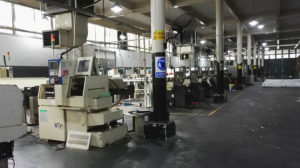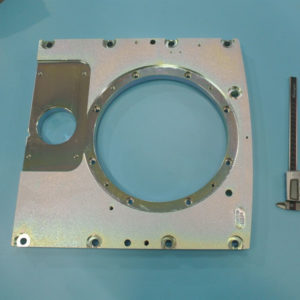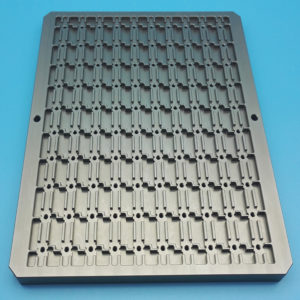First, the dimensional tolerance, shape tolerances, surface roughness on the numerical relationship. CNC Machining: China CNC Machining Factory offers precision CNC
1. Numerical relationship between shape tolerance and dimensional tolerance
When the dimensional tolerance accuracy is determined, the shape tolerance has a proper value corresponding to it, ie generally about 50% dimension tolerance value as the shape tolerance value; the instrument industry about 20% dimension tolerance value as the shape tolerance value; heavy industry About 70% dimension tolerance values are used as shape tolerance values. This shows that. The higher the dimensional tolerance accuracy, the smaller the shape tolerance is in the proportion of the dimensional tolerance. Therefore, when designing the dimension and shape tolerance requirements, except for special cases, when the dimensional accuracy is determined, the 50% dimension tolerance value is generally used as the shape tolerance value. This is both conducive to manufacturing and also conducive to ensuring quality. CNC Machining: China CNC Machining Factory offers precision CNC
2. Numerical relationship between shape tolerance and position tolerance
There is also a certain relationship between shape tolerance and position tolerance. From the formation of the cause of the error, the shape error is caused by the machine vibration, tool vibration, spindle bouncing and other reasons; and the position error is due to the non-parallel machine tool rails, tool clamping is not parallel or vertical, the role of clamping force and other reasons Caused by, from the tolerance zone definition, the position error is the shape error of the surface to be measured. If the parallelism error contains the flatness error, the position error is much larger than the shape error. Therefore, in the general case, when there is no further requirement, the position tolerance is given and the shape tolerance is no longer given. When there are special requirements, the shape and position tolerance requirements can be marked at the same time, but the marked shape tolerance value should be less than the marked position tolerance value. Otherwise, parts cannot be manufactured according to design requirements during production.
3. Relationship between shape tolerance and surface roughness
Although there is no direct relation between the shape error and the surface roughness in terms of numerical value and measurement, there is a certain proportional relationship between the two under certain processing conditions. According to experimental research, in the general accuracy, the surface roughness accounts for the shape tolerance. 1/5 to 1/4. It can be seen that the maximum allowable value of the corresponding surface roughness height parameter should be appropriately limited in order to ensure the shape tolerance. CNC Machining: China CNC Machining Factory offers precision CNC
In general, tolerance values between dimensional tolerances, shape tolerances, position tolerances, and surface roughness have the following relationships: Dimensional Tolerance> Position Tolerance> Shape Tolerance> Surface Roughness Height Parameters
From the numerical relationship between size, shape and surface roughness, it is not difficult to see that the numerical relationship between the three should be coordinated and handled when designing. When marking tolerance values on a pattern, it should be observed that the roughness value given on the same surface should be less than The shape tolerance value; and the shape tolerance value should be smaller than the position tolerance value; the position difference should be smaller than its dimension tolerance value. Otherwise, it will cause all kinds of troubles. However, the most involved design work is how to deal with the relationship between dimensional tolerances and surface roughness and the relationship between various mating precisions and surface roughness.
Under normal circumstances determined by the following relationship:
1. When the shape tolerance is 60% of the dimensional tolerance (medium relative geometric accuracy), Ra≤0.05IT;
2. When the shape tolerance is 40% of the dimensional tolerance (higher relative geometric accuracy), Ra≤0.025IT;
3. When the shape tolerance is 25% of the dimensional tolerance (high relative geometric accuracy), Ra≤0.012IT;
4. When the shape tolerance is less than 25% of the dimensional tolerance (super high relative geometric accuracy), Ra ≤ 0.15Tf (shape tolerance value).
The simplest reference: The dimensional tolerance is 3-4 times the roughness, which is the most economical.
Second, the choice of shape and position tolerance
1, the choice of geometric tolerance items
The functions of the comprehensive control project should be fully utilized to reduce the geometric tolerance items given on the drawings and the corresponding shape and position error detection items. CNC Machining: China CNC Machining Factory offers precision CNC
On the premise of satisfying the functional requirements, a simple measurement project should be selected. For example: Concentricity tolerances are often replaced by radial round runout tolerances or radial round runout tolerances. However, it should be noted that the radial runout is a combination of the coaxiality error and the cylindrical surface shape error, so when it is replaced, the runout tolerance value given should be slightly larger than the coaxiality tolerance value, or it will be overly stringent.
2, the choice of tolerance principles
Based on the functional requirements of the measured elements, the functions of the tolerances should be fully utilized and the feasibility and economy of the principle of the tolerance should be taken into consideration.
The principle of independence is used for large differences in precision between dimensional accuracy and positional accuracy, which need to meet the requirements, or no connection between the two, to ensure motion accuracy, sealability, and no tolerance tolerances.
Containment requirements are mainly used in applications where strict coordination is required.
The largest entity is required for the central element and is generally used when the fitting requirements are assembly (no compatibility requirements).
The minimum physical requirements are mainly used in applications where parts strength and minimum wall thickness are required.
Reversible requirements are used in conjunction with maximum (minimum) entity requirements, allowing full use of tolerance zones, extending the range of actual dimensions of measured elements, and improving efficiency. It can be used without affecting the performance. CNC Machining: China CNC Machining Factory offers precision CNC
3, the choice of benchmark elements
1) Selection of reference sites
(1) Select the joint surface where the parts are located in the machine as the reference site. For example, the bottom plane and side of the box, the axis of the disk parts, the bearing journals or support holes of the rotating parts, etc.
(2) The reference elements should have sufficient size and rigidity to ensure stable and reliable positioning. For example, using two or more axes that are farther apart, the common reference axis is more stable than one reference axis.
(3) Choose the surface with more accurate machining as the reference site.
(4) Try to make the assembly, processing and testing standards uniform. In this way, errors due to inconsistent references can be eliminated; the design and manufacture of fixtures and measuring tools can also be simplified and measurement can be facilitated.
2). Determination of the number of benchmarks
In general, the number of datums should be determined based on the orientation of the tolerance items and the positioning geometry requirements. Most orientation tolerances require only one reference, while positioning tolerances require one or more references. For example, for the parallelism, perpendicularity, and concentricity tolerance items, only one plane or one axis is generally used as the reference element; for positional degree tolerance items, the positional accuracy of the hole system needs to be determined, and two or three may be used. Benchmarking elements. CNC Machining: China CNC Machining Factory offers precision CNC
3). Baseline arrangement
When more than two reference elements are selected, the order of the reference elements should be clearly defined and written in the tolerance grid in the order of the first, second and third. The first reference element is the main one, and the second reference element is the second one. .
4, the choice of geometric tolerance values
General principle: Select the most economical tolerance value on the premise of meeting the function of the part.
◆ According to the functional requirements of the parts, consider the economics of processing and the structure and rigidity of the parts, and determine the tolerance values of the elements according to the table. And consider the following factors:
◆ The same element gives the shape tolerance should be less than the position tolerance value;
◆ The tolerance value of the shape of a cylindrical part (except for the straightness of the axis) should be smaller than its dimensional tolerance value; if the same plane, the flatness tolerance value should be smaller than the parallelism tolerance value of the plane to the reference.
◆ The parallelism tolerance value should be less than its corresponding distance tolerance value. CNC Machining: China CNC Machining Factory offers precision CNC
◆ Approximate proportional relationship between surface roughness and shape tolerance: Generally, the Ra value of the surface roughness can be taken as the shape tolerance value (20% to 25%).
◆ For the following cases, taking into account the ease of processing and the influence of factors other than the main parameters, to meet the requirements of the function of the parts, appropriately reduce the 1 to 2 level selection:
○ hole relative to the axis;
○ slender shafts and holes; larger shafts and holes;
○ Larger (greater than 1/2 length) part surface;
○ Line-to-face versus line-to-face parallelism, perpendicularity tolerances. CNC Machining: China CNC Machining Factory offers precision CNC
5, the provisions of the shape of the position without tolerance
In order to simplify the drawing, the accuracy of the positional position can be guaranteed for the general machine tool processing, and it is not necessary to indicate the geometrical position tolerance on the drawing. The unpositioned tolerance of the shape position is to be implemented according to the provisions of GB/T1184-1996. The general content is as follows:
(1) The three tolerance classes H, K, and L are specified for the uninjected straightness, flatness, verticality, symmetry, and round runout.
(2) Unrounded roundness The tolerance value is equal to the diameter tolerance, but it cannot be greater than the unalerted tolerance of the radial runout.
(3) Uncalibrated cylindricity tolerance values are not specified. They are controlled by the roundness tolerance of the elements, the straightness of the straight line, and the injection or unfilled tolerances of the relative line parallelism.
(4) The maximum value of the uninjected parallelism tolerance value equal to the dimensional tolerance between the measured element and the reference element and the unassigned tolerance value of the measured element’s shape tolerance (straightness or flatness), and takes two The longer of the elements serves as a benchmark.
(5) There is no specification for the value of uninjected coaxiality tolerance. If necessary, the unadjusted tolerance of the desired concentricity is equal to the unalerted tolerance of the circle run. CNC Machining: China CNC Machining Factory offers precision CNC
(6) The tolerance values for contour profile, profile, incline, and position are all controlled by the injection or non-injection linear dimension tolerance or angle tolerance of each element.
(7) There is no specification for the value of the full runout tolerance.
6. Pattern representation of unmarked tolerance values
If the un-noted tolerance value specified in GB/T 1184-1996 is used, the standard and grade code should be noted in the title bar or technical requirements.
: “GB/T1184-K”. The
The work tolerance of “Tolerance principle according to GB/T 4249” is not marked on the drawing and shall be performed according to the requirements of “GB/T 1800.2-1998”. CNC Machining: China CNC Machining Factory offers precision CNC
CNC Machining Service & CNC Machining parts

CE Approved rapid prototype and manufacturing Manufacturer

Expert Manufacturer of CNC machining prototype

rapid machining services OEM Manufacturer
